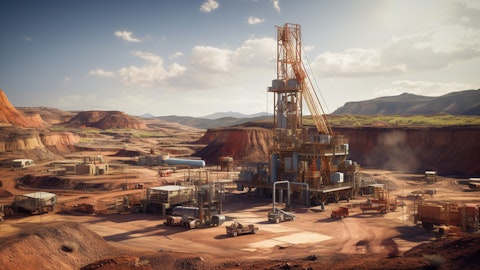Operator: Your next question comes from the line of Brian MacArthur with Raymond James.
Brian MacArthur: It goes back to what Alex was asking in Bagdad. So I just want to make sure as I look at these numbers, so the project capital is $3.5 billion. And I would have to think you get some in structure benefit there, so it’s not a true greenfield. And then you talk about a $3.50 to $4 incentive copper prices, and I understand the benefits of new royalties and taxes. Does that sort of say that if you didn’t have infrastructure, the capital costs would have been higher. And if you didn’t have all these tax benefits, the incentive price would be an awful lot higher, i.e., if anybody else had to do a greenfield there, you’d probably need a incentive price well over $4 to make it work, i.e., those numbers include all the tax benefits and everything that you were talking about before, if I can ask the question that way.
Kathleen Quirk: Brian, if somebody else has the same situation, greenfield and the grades we have, it would be a lot more, a lot more expensive.
Richard Adkerson: A lot more. And your $4 is absolutely right. I mean you just look at recent projects and look at how costs escalate and then what would have taken from an incentive price to justify that project from the outset if the cost numbers have been known. So this is not that complicated. So it’s not a greenfield project. We’ve operated there for 80 years or so. And it’s about a straightforward project as you could have, but it’s telling for the industry even with this kind of straightforward project the challenge you face. It’s cost, it’s tailings and we do benefit from infrastructure. This is just a mill expansion. It’s not building a new mine. But then there’s a challenge of getting workers and housing for workers.
So all of this is real telling on the supply side — I just talked about the demand side support for copper. So this is a great example of a simple project in terms of the relative complexities of projects in our industry, this is relatively simple. And yet, it faces these challenges of being economically justified in today’s price. At the outset, I said today’s copper price is not a price that’s adequate to stimulate the kind of investments that are going to be needed for this industry. And that’s why we’re optimistic about future prices.
Brian MacArthur: And maybe if I could just ask just on the capital allocation. I mean, you’ve got lots of options, as you said. But if you’re successful for Phase 3, I mean you get as much production there as you would hear, I assume a fraction of the capital cost. Does Bagdad get pushed in that situation? I mean, I get that the world needs probably all of it. But would they get sequenced or are they complementary? I mean I know they don’t depend on each other, but are they complementary and you would do both at once if both work?
Kathleen Quirk: We’re prioritizing the leach initiative. I mean that is one that’s a no-brainer for us. It’s very, very little capital that we’re investing in it and very low increment — it’s our lowest incremental operating cost of anything in the US. And so that’s a no-brainer. We’re pursuing that regardless, that makes a ton of sense and we’re pursuing that regardless. We think the world is going to need something beyond that, obviously. And so on the Bagdad thing, we just want to get it, get it to where — continue to enhance the optionality in it, and we need to do some things anyway. We’re doing some infrastructure on tailings that we would need to do anyway in the future, maybe not as quickly as what we would need with the new project, but we need to do those anyway.
So we’re going to do those to the extent we can do that efficiently. We want this autonomous thing that we’re pursuing. Years ago, people thought you didn’t really need autonomous in the US. But now, particularly in these remote locations, you really, really do when you consider the cost of the workforce and the housing limitations and that sort of thing and the opportunities to upscale our employees, we think it checks all of those boxes. So autonomous, we want that to see how that unfolds. So we don’t have to pull the trigger on Bagdad now but we want to put it in a position where it can go forward. It makes sense if the world needs more copper to get copper from where we already have it. And so it does — it’s a good project, it’s not a barn burner from an economic standpoint, right now.
But it will have its day and I think it will get time at some point, it just we aren’t predicting exactly when.
Richard Adkerson: And Brian, we got a strong enough financial position that we can — capital is not a barrier for us to do in projects that make sense.
Operator: Your next question comes from the line of Alan Spence with BNP Paribas.
Alan Spence: You highlighted the record [Technical Difficulty]…
Richard Adkerson: Alan, you’re breaking up on us.
Alan Spence: I’ll try again, hopefully — hear me…
Kathleen Quirk: Yes, that’s better.
Alan Spence: The strong performance for [Technical Difficulty] in [December], is that a level you think could potentially be [Technical Difficulty] through ’24 or was there something unique about what happened last month? And also, if you could remind me in terms of timeline to get to 240,000 tons per day run rate?
Kathleen Quirk: With respect to [Multiple Speakers] I was going to say Mark Johnson is on the line, he can add to it if you want. But with respect to December, it highlights, we got that SAG mill completed, the new SAG mill completed in December So really, that gave us the ability to put more ore throughput through the concentrators. And with the combination of higher grades and strong recoveries, we had a great month. Now we have the ability to continue to have strong performance. We achieved a lot of records in December but we do have the ability and some upside to continue that. That SAG mill was originally put in the plan because over time, we’ll need the additional grinding capacity, et cetera, to take the ore that will be coming.





